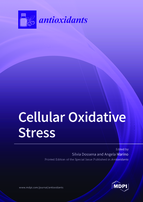Cellular Oxidative Stress
A special issue of Antioxidants (ISSN 2076-3921). This special issue belongs to the section "Health Outcomes of Antioxidants and Oxidative Stress".
Deadline for manuscript submissions: closed (30 September 2020) | Viewed by 109692
Special Issue Editors
Special Issues, Collections and Topics in MDPI journals
Interests: hearing loss; gene analysis; SLC26A4/pendrin; Pendred syndrome; Enlarged Vestibular Aqueduct (EVA); ion transport; functional testing; ion channels; ion exchangers; oxidative stress
Special Issues, Collections and Topics in MDPI journals
Special Issue Information
Dear Colleagues,
We invite you to submit your valuable and latest research outcomes for publication in the Special Issue entitled "Cellular Oxidative Stress" for the journal Antioxidants (MDPI).
This Special Issue will focus on the impact of oxidative stress at the cellular level, providing more knowledge about oxidative damage mechanisms on cells, their components (i.e., the plasma membrane and organelles) and molecules (i.e., DNA, RNA, signaling proteins, enzymes, and ion channels and transporters). Any of the following topics may be included: diseases related to oxidative stress, including, but not limited to neurodegenerative and inflammatory diseases and diabetes; aging; redox systems; role of cellular components in possible adaptive changes against oxidative stress; beneficial effect of natural and synthetic antioxidants.
Research articles collecting data from both in vitro (e.g., cell cultures and erythrocytes) and in vivo (rodents model) investigations are welcome. In addition, review articles reporting about the mode of actions of oxidants and antioxidants would complete the topic.
Dr. Angela Marino
Dr. Silvia Dossena
Guest Editor
Manuscript Submission Information
Manuscripts should be submitted online at www.mdpi.com by registering and logging in to this website. Once you are registered, click here to go to the submission form. Manuscripts can be submitted until the deadline. All submissions that pass pre-check are peer-reviewed. Accepted papers will be published continuously in the journal (as soon as accepted) and will be listed together on the special issue website. Research articles, review articles as well as short communications are invited. For planned papers, a title and short abstract (about 100 words) can be sent to the Editorial Office for announcement on this website.
Submitted manuscripts should not have been published previously, nor be under consideration for publication elsewhere (except conference proceedings papers). All manuscripts are thoroughly refereed through a single-blind peer-review process. A guide for authors and other relevant information for submission of manuscripts is available on the Instructions for Authors page. Antioxidants is an international peer-reviewed open access monthly journal published by MDPI.
Please visit the Instructions for Authors page before submitting a manuscript. The Article Processing Charge (APC) for publication in this open access journal is 2900 CHF (Swiss Francs). Submitted papers should be well formatted and use good English. Authors may use MDPI's English editing service prior to publication or during author revisions.
Keywords
- Oxidative stress
- Antioxidants
- Cellular components
- Oxidative stress-related diseases
Related Special Issue
- Redox Regulation of Cell Signalling in Antioxidants (11 articles)








